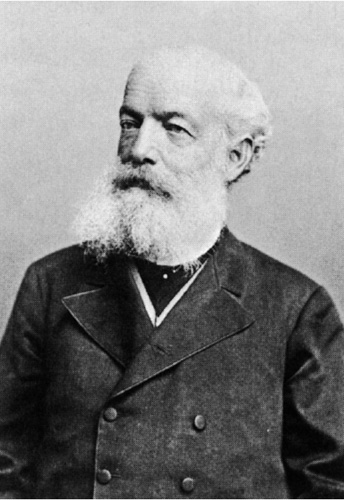
This Article From Issue
November-December 2010
Volume 98, Number 6
Page 500
DOI: 10.1511/2010.87.500
IMAGE AND REALITY: Kekulé, Kopp, and the Scientific Imagination. Alan J. Rocke. xxvi + 375 pp. The University of Chicago Press, 2010. $45.
The theory of chemical structure, although it rarely receives the kind of attention accorded the theory of evolution or even the periodic table, is nevertheless a landmark achievement of 19th-century science. As Alan J. Rocke notes in Image and Reality, it was “the first truly successful entry by human minds and tools into the realm of the invisibly small.” According to Rocke, it also represented the crowning achievement of a widely dispersed community of individuals with vivid scientific imaginations.

From Image and Reality.
Rocke’s central argument is that imagination plays a productive role in the endeavors of prominent scientists. The book, however, is hardly an abstract analysis of scientific talent. To support his claim, Rocke offers readers a compact and accessible history of the emergence of the theory of chemical structure as scientists sought to determine the arrangement of atoms and molecules. His account encapsulates the high points of more than 30 years of research on 19th-century chemistry. This is no mean feat, for the main tenets of structure theory—unlike those of the theory of evolution or special relativity—are not embodied in a single publication or a short series of publications. Structure theory emerged gradually through the efforts of a network of chemists distributed across several countries, not all of whom were aware of one another’s work. Rocke focuses on just a handful of key figures in this network. Although this strategy involves some sacrifice of detail, it leads to a digestible account of the complexities of distributed innovation and an engaging and human tale of investigation and imagination.
Rocke’s account begins in London in 1850, where chemist Alexander W. Williamson was presenting papers reporting the results of his groundbreaking research on different varieties of ether and alcohol. These studies provided chemists with new means of deducing from the behavior of substances in a beaker how many atoms there were in a chemical compound and how those atoms were linked. This opened the way for experimental investigations to determine relative atomic weights and to discover the relationships between the atoms in a molecule. Over the course of the next 15 years, French, English and especially German chemists feverishly redefined the very bases of chemical formulas and models.
Although Rocke fastidiously credits each of more than a dozen chemists for their respective contributions to these transformations, he focuses on the work of August Kekulé. Were Kekulé not already an acknowledged pioneer of structure theory, Rocke might be accused here of stacking the deck in favor of imagination. Kekulé, who was the son of a Hessian military adviser with a passion for architecture, started out studying architecture at the University of Giessen in Germany. He soon switched to chemistry, but he remained forever after an avowedly visual thinker. He was making extensive use of his distinctive “sausage” models of molecules a decade before any standard representation of molecular structure emerged. (To give a sense of what these were like, Rocke mentions that in the sausage model for an atom of carbon, each of four interconnected bulges represents a single carbon valence, and a hoodlike “casing” covers them all to indicate that this is a single atomic structure.)
Of course Kekulé is also famous for his two dreams, or daydreams, of chemical structure, which have fascinated science writers of all sorts for more than a century. In the first of these, he sees atoms “gamboling” and pairing off, larger ones seizing smaller ones, all moving “in a whirling dance” and forming chains, with larger atoms dragging smaller ones along. He concludes his account of the dream with the statement that “This was the birth of the structure theory.” In the second dream, which takes place several years later, atoms flutter before him in long lines, “twisting and turning like snakes.” Then one snake seizes its own tail and whirls in front of him. He awakens and realizes that benzene has a cyclical structure.
In focusing on Kekulé, Rocke is not sacrificing accuracy or accessibility for the sake of argument. Kekulé contributed two of the earliest and best-known articles on structure theory, and the story of his career serves as an excellent vehicle for describing the community of chemists in which the theory developed. After studying in Giessen, Kekulé spent a year in Paris attending lectures by the likes of Jean-Baptiste Dumas and Adolphe Wurtz. He then moved on to London, where he met and greatly impressed Williamson. There Kekulé also discussed “chemical philosophy” in informal meetings with fellow expatriate German chemists. It was also in London that he reportedly had the first of his famous daydreams.
So by the time Kekulé began his academic career in earnest, as an unpaid lecturer at the University of Heidelberg, he had already encountered some of the most prominent luminaries and most puzzling enigmas in chemistry. At Heidelberg—in a cramped, private lecture hall and laboratory, surrounded by students who would rank among the most famous German chemists of the next generation—Kekulé came to terms with those earlier encounters, synthesized his experiences and composed his two epochal articles on structure theory.
These articles helped earn Kekulé a professorship in Ghent, where he wrote a renowned textbook on chemistry that candidly discussed a host of questions left unanswered by his earlier articles. Rocke uses these open questions as an opportunity to broaden his focus and to introduce several chemists—some famous, some almost forgotten—who published tracts on chemical structure at roughly the same time as Kekulé. The overlaps among these various researches have inspired several priority disputes. Rocke acknowledges these and dutifully evaluates them but manages to avoid fruitless questions of precedence. He instead uses discussions of scientific credit as a tool to break structure theory down into its constituent parts and make its historical development clearer.
Rocke then offers a condensed account of how structure theory continued to evolve during the 1860s and 1870s. He emphasizes the increasing detail with which chemists discussed and represented molecular structure. Although he maintains his focus on human actors and his attention to detail never wanes, this latter section reads more like a historical survey. Rocke introduces the reader to Hermann Kolbe, inveterate critic of structure theory; Jacobus H. van’t Hoff and Joseph Le Bel, heroes of stereochemistry; and Rudolf Clausius, pioneer of the kinetic theory of heat. But none of these figures is treated with the thoroughness afforded Kekulé.
The goal of this survey and the logic of the book as a whole become clear in the final chapters of Image and Reality, where Rocke narrows his focus to three exemplars of chemists’ informal, imaginative and singularly visual musings on the world of atoms and molecules. Here the chemical imagination is constantly at the fore, and Rocke shows its effects on almost every aspect of structure theory previously discussed. A “fairy tale” of atomic scale by Hermann Kopp and an anonymous mock conference proceeding demonstrate the amazing free rein that chemists allowed their imaginations in their informal writings. According to Rocke, these works also offer an oblique but crucial insight into the private mental lives of chemists. Kekulé’s famous daydreams, read in their proper historical context, show that successful chemists meticulously and circumspectly interrogated their private imaginings before pronouncing them to the scientific public.
But as Rocke is the first to admit, proving that imagination plays a role in any given scientific endeavor is a difficult, if not impossible, task. Private reveries leave no paper trail. There is also a clear and never fully resolved tension in Image and Reality between imagination as a private faculty and the communal development of scientific theory. Proving that scientists do not use their imaginations in formulating new scientific theories is, however, no easier than proving that they do. We are limited, for the time being, to finding the most plausible account. And Rocke provides a persuasive argument that imagination is a likely factor in scientific creativity, one that we ignore at the risk of a sanitized and sterile view of scientific research.
Jeremiah James is a researcher at the Fritz Haber Institute of the Max Planck Society in Berlin. He is writing a history of the Institute.

American Scientist Comments and Discussion
To discuss our articles or comment on them, please share them and tag American Scientist on social media platforms. Here are links to our profiles on Twitter, Facebook, and LinkedIn.
If we re-share your post, we will moderate comments/discussion following our comments policy.